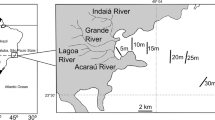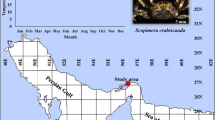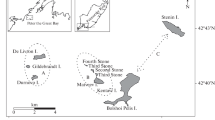Abstract
The ecology of the spider crab Inachus phalangium (Fabricius, 1775) (Decapoda: Maiidae) was studied in the field. I. phalangium inhabits the sublittoral on the sea anemone Anemonia sulcata Pennant. From July 1981 to April 1984 in the Mediterranean (Banyuls sur Mer, southern France) more than 3000 anemones were examined and ca 1800 I. phalangium were found on them. The population dynamics' generation cycles, reproductive activities and the dynamics of the sex ratio were investigated. The density of juveniles (crabs before the pubertal moult) on anemones changed in a yearly cycle from low in the first six months to very high in the second six months. The first occasional young crabs of a generation appeared in March/April (3rd and 4th decapodite stages) on the anemones. Their density increased enormously in the following months. The generation grew gradually on the anemones and moulted into puberty in September-January. Density of adults (crabs after the pubertal moult) on anemones changed in a yearly cycle from low to high from the summer to winter months. A new adult generation was recruited every autumn through the pubertal moult and disappeared in the following summer. Female reproductive activity continued throughout the year. Females carried several broods in succession, but the frequency of breeding females fluctuated on a yearly cycle. The highest percentage of egg-carrying females, i.e. the peak of the reproductive season, lay in the first half of the year. The maximal life span of a generation, from the hatching of the first larvae to the disappearance of the last adults, lasted 1.5 to 2 years. Males moulted into puberty ca one month later than females. The moulting distribution of adult males had roughly the same course as in females. An adult male generation diet out about one to two months before the female generation. Life expectancy was therefore 14 to 17 months for females and 12 to 15 months for males. The sex ratio of juveniles shortly before the pubertal moult was balanced. The sex ratio of adults shifted from 1:1 at the beginning of the reproductive period to ca 1:9 in favour of females at its end.
Similar content being viewed by others
Literature cited
Bhaud, M., G. Jacques and C. Razouls: Donnés météorologiques et hydrologiques de la region de Banyuls-sur-Mer. Année 1965–1966 (Point Côtier). Vie Milieu 18, 137–151 (1967)
Bourdon, R.: Inventaire de la faune marine de Roscoff: Decapodes et Stomatopodes. Trav. Stn. biol. Roscoff 16, 1–45 (1965)
Calgren, O.: Actinaria II. Dan. Ingolf. Exped. 5, 1–95 (1942)
Diesel, R.: Optimal mate searching strategy in the symbiotic spider crab Inachus phalangium (Decapoda). Ethology (In press)
Diesel, R.: Male mate choice, mate guarding and mating frequencies in the symbiotic spider crab Inachus phalangium (Decapoda: Maiidae). (In preparation a)
Diesel, R.: Structure and function of the reproductive system of the symbiotic spider crab Inachus phalangium (Decapoda). (In preparation b)
Hartnoll, R. G.: The biology of Manx spider crabs. Proc. zool. Soc. Lond. 141, 423–496 (1963)
Hartnoll, R. G.: The biology of spider crabs: a comparison of British and Jamaican species. Crustaceana 9, 1–16 (1965)
Hartnoll, R. G.: The relationship of an amphipod and a spider crab with the snakelocks anemone. Ann. Rep. mar. biol. Stn. Port Erin 83, 37–42 (1970)
Jacques, G., C. Razouls and A. Thiriot: Données météorologiques et hydrologiques de la region de Banyuls-sur-Mer. Année 1966–1967 (Point Côtier). Vie Milieu 19, 185–195 (1968)
Jacques, G., C. Razouls and A. Thiriot: Climat et hydrologie a Banyuls-sur-Mer (Golfe du Lion) 1965–1968. Vie Milieu 20, 279–316 (1969)
Jacques, G., C. Razouls and A. Thiriot: Données météorologiques et hydrologiques de la region de Banyuls-sur-Mer. Année 1968–1969 (Point Côtier). Vie Milieu 22, 61–74 (1971)
Johnson, V. R.: Behavior associated with pair formation in the banded shrimp Stenopus hispidus (Olivier). Pacif. Sci. 23, 40–50 (1969)
Knowlton, N.: Sexual selection and dimorphism in two demes of a symbiotic pair-bounding snapping shrimp. Evolution 34, 161–173 (1980)
Knudsen, J. W.: Trapezia and Tetralia (Decapoda, Brachyura, Xanthidae) as obligate ectoparasites of pocilloporid and acroporid corals. Pacif. Sci. 21, 57 (1967)
MacGinitie, G. E.: Ecological aspects of a Californian marine estuary. Am. Midl. Nat. 16, 630–765 (1935)
MacGinitie, G. E.: Notes on the natural history of several marine Crustacea. Am. Midl. Nat. 18, 1031–1037 (1937)
Manning, R. B. and L. B. Holthuis: West African brachyuran crabs (Crustacea: Decapoda). Smithsonian Contr. Zool. 306, 1–353 (1981)
Patton, W. K.: Decapod Crustacea commensal with Queensland branching corals. Crustaceana 10, 271–295 (1966)
Patton, W. K.: Community structure amongst the animals inhabiting the coral Procillopora damicornis at Heron Island, Australia. In: Symbiosis in the sea. Ed. by W. B. Vernberg. Columbia 1, 219–243 (1974)
Perez, C.: Caractères sexuels chez un crabe oxyrhynque (Macropodia rostrata L.). C. R. Acad. Sci. Paris 188, 91–93 (1928)
Preston, E. M.: A computer simulation of competition among five sympatric congeneric species of xanthid crabs. Ecology 54, 469–483 (1973)
Raso, J. E. G.: Brachyura of the coast of southern Spain (Crustacea, Decapoda). Sphinxiana 7, 105–113 (1984)
Razouls, C.: Données climatologiques de la region de Banyuls-sur-Mer. Années 1971 et 1972. Vie Milieu 24, 81–92 (1974)
Sachs, L.: Angewandte Statistik, 552 pp. Berlin: Springer Verlag 1978
Schmidt, H.: Prodomus zu einer Monographie der mediterranen Aktinien. Zoologica Stuttg. 121, 1–146 (1972)
Siegel, S.: Nonparametric statistics, 312 pp. Kogakusha: McGraw Hill 1956
Sokal, R. R. and F. J. Rohlf: Biometry, 2nd ed. 859 pp. San Francisco: W. H. Freeman and Company 1981
Stevcic, Z.: Beitrag zur Revision der Decapodenfauna der Umgebung von Rovinj. Thalassia jugosl. 7, 525–531 (1971)
Türkay, M.: Marine Crustacea Decapoda von den Kapverdischen Inseln mit Bemerkungen zur Zoogeographie des Gebietes. Cour. Forsch. Inst. Senckenberg 52, 91–129 (1982)
Vadon, C.: Les Brachyoures des herbiers de Posedonies dans la region de Villefranche-sur-Mer: biologie, écologie et variations quantitatives des populations. Thèse 3e cycle. Univ. Pierre et Marie Curie, Paris 1981
Weinbauer, G., V. Nussbaumer and R. A. Patzner: Studies on relationship between Inachus phalangium Fabricius (Maiidae) and Anemonia sulcata Pennant in their natural environment. P.S.Z.N.I. Mar. Ecol. 3, 143–150 (1982)
Wirtz, P. and R. Diesel: The social structure of Inachus phalangium, a spider crab associated with the sea anemone Anemonia sulcata. Z. Tierpsychol. 62, 209–234 (1983)
Zariquiey, A. R.: Crustaceos decapods ibericos. Investigation pesqu. 32, 1–510 (1968)
Author information
Authors and Affiliations
Additional information
Communicated by O. Kinne, Oldendorf/Luhe
Rights and permissions
About this article
Cite this article
Diesel, R. Population dynamics of the commensal spider crab Inachus phalangium (Decapoda: Maiidae). Marine Biology 91, 481–489 (1986). https://doi.org/10.1007/BF00392599
Accepted:
Issue Date:
DOI: https://doi.org/10.1007/BF00392599




